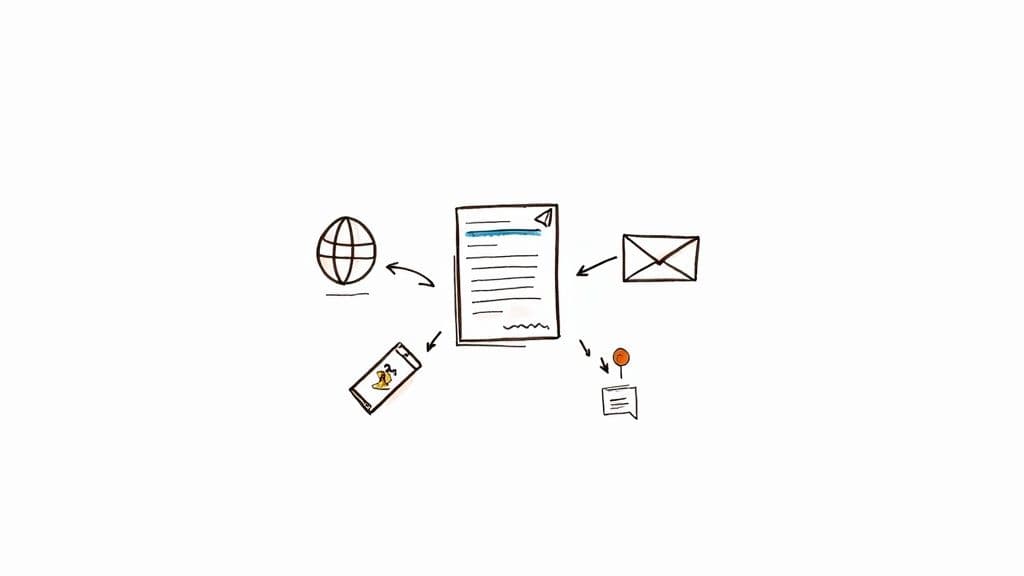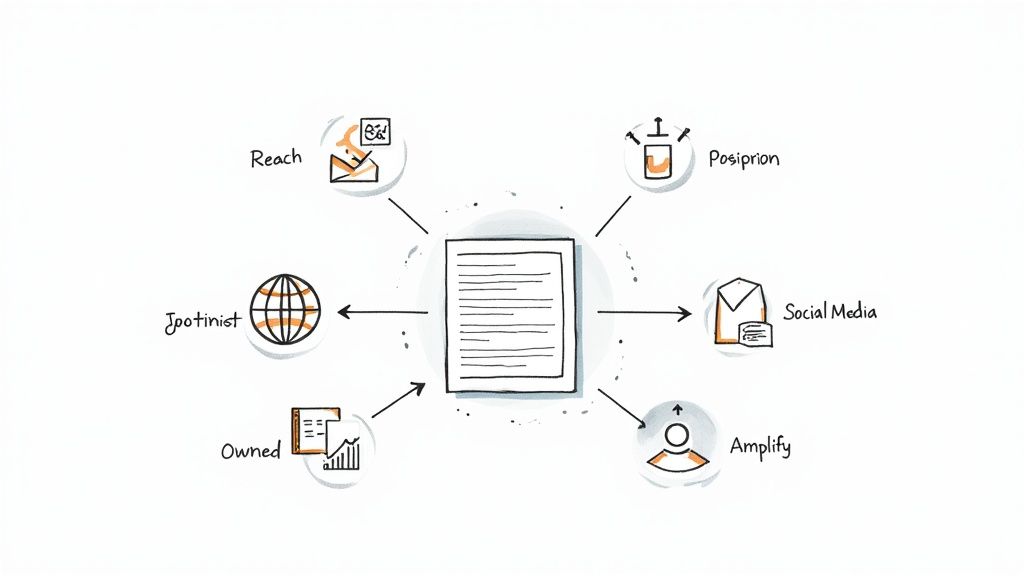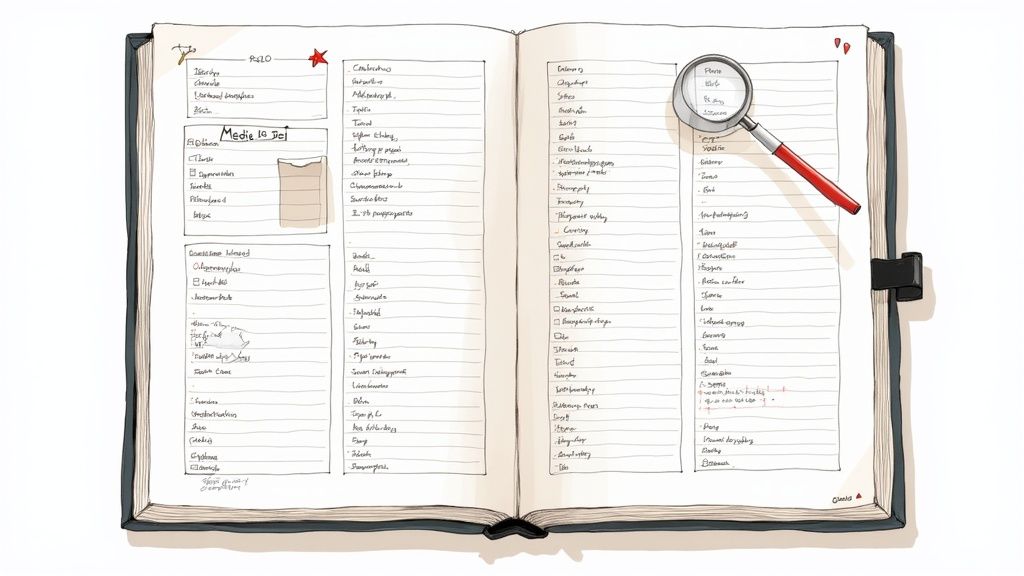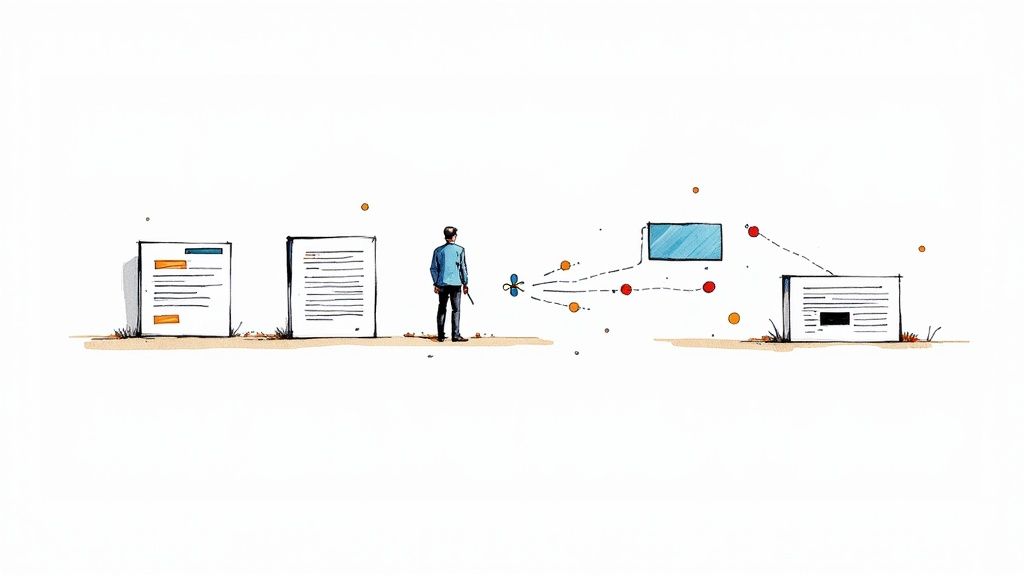How to Distribute a Press Release for Maximum Impact
November 9, 2025

Getting your press release out there isn't what it used to be. A truly effective distribution plan today is a multi-pronged attack that goes way beyond just blasting it out into the void.
You need to combine the massive reach of newswire services, the surgical precision of direct journalist outreach, and the sustained buzz from your own social media channels. This hybrid approach is what separates a press release that gets noticed from one that disappears without a trace.
Your Modern Press Release Distribution Blueprint
Thinking about how to get your press release seen can feel like a huge task, but it really comes down to an integrated strategy. The old method of sending a single fax and crossing your fingers is long gone.
Real impact today comes from creating a surround-sound effect, where your announcement pops up across multiple touchpoints all at once. This is how you grab the attention of reporters, potential customers, and key industry players simultaneously.
The game has changed. Strategic placement and engaging multimedia are now the names of the game. A pro tip I always share is to avoid sending anything out on Fridays or during holiday weeks—media attention is just focused elsewhere. And including visuals like photos and videos? That's not a suggestion anymore; it's essential for getting your story picked up. To really get a leg up, you should dig into some modern press release distribution best practices.
The Three Pillars of Modern Distribution
A successful campaign is built on three core pillars that work together. Think of them as a three-legged stool—if one is weak, the whole thing wobbles.
- Newswire Services: This is your megaphone. Platforms like PR Newswire or Business Wire give you broad, instant reach, pushing your news to hundreds (sometimes thousands) of media outlets and online portals. It’s all about maximum visibility, fast.
- Direct Outreach: This is your sniper rifle. You build a hand-picked list of journalists who actually cover your industry and send them personalized pitches. This is how you land those high-quality, in-depth stories in the publications that your target audience really reads.
- Owned Media Amplification: Your job isn’t over once the release is sent. You need to use your own channels—your website’s newsroom, your company blog, and all your social media accounts—to share and talk about the news. This keeps the momentum going and drives people directly to your announcement.
This flow shows how all three elements should work in harmony.

As you can see, the strategy flows from broad awareness (the newswire) to targeted engagement (direct outreach) and is followed by sustained momentum (social media). This creates a powerful, layered effect that gives your news the best possible chance of making a real impact. Each step builds on the last, ensuring your story gets to the right people through the right channels.
Comparing Press Release Distribution Channels
Choosing the right mix of channels can be tricky. Each has its own strengths and is suited for different goals. This quick comparison breaks down the main options to help you decide where to focus your efforts.
| Channel | Best For | Key Advantage | Potential Downside |
|---|---|---|---|
| Newswire Services | Broad, immediate announcements; reaching financial markets; building online visibility (SEO). | Unmatched speed and reach. Gets your news into countless databases and newsfeeds instantly. | Can be expensive and impersonal. Your release is one of many, making it hard to stand out. |
| Direct Outreach | Securing in-depth stories, feature articles, and interviews in high-value publications. | Building real relationships with journalists and earning high-quality, credible coverage. | Extremely time-consuming. Requires research, personalization, and follow-up with no guarantee of a response. |
| Owned Media | Engaging your existing audience, driving website traffic, and controlling the narrative. | Complete control over the message and timing. It's your platform to tell your story your way. | Reach is limited to your existing followers. It's difficult to reach new audiences without a paid boost. |
Ultimately, the most powerful strategies don't rely on just one of these. They blend the scale of a newswire with the precision of direct outreach and the ongoing engagement of owned media to create a campaign that truly delivers results.
Selecting the Right Press Release Wire Service
Picking the right press release distribution service is one of those make-or-break decisions that can define your entire campaign. This isn't a one-size-fits-all situation. The right partner will get your story in front of the right people, while the wrong one is just a good way to burn through your budget with little to show for it.
I like to think of it like choosing a vehicle. A Ferrari is amazing for a pristine racetrack, but it’s completely useless if your destination is at the end of a muddy, unpaved road. In the same way, a premium service like PR Newswire is a powerhouse for a major corporate announcement, but a more focused, budget-friendly option might be the smarter play for a startup launching a niche product.
First, Figure Out What You Actually Need
Before you even start comparing prices, you need to get crystal clear on your goals. The "best" service is simply the one that aligns with what you're trying to achieve.
Start by asking yourself these fundamental questions:
- Who are you trying to reach? Are you targeting Wall Street Journal reporters, local TV news desks, or hyper-specific industry bloggers? The audience dictates the channel.
- How far does your news need to travel? Is this a local story for Dallas, a nationwide announcement, or a global launch across multiple continents?
- What’s the budget? Seriously. Costs can swing from under a hundred dollars to several thousand, so you need a realistic number in mind.
- What features are deal-breakers? Do you absolutely need to embed a video? Are multiple images critical? Is a detailed analytics report a must-have for your stakeholders?
Answering these questions first will help you cut through the marketing fluff and zero in on the services that are a genuine fit for your campaign. For a closer look at the different providers, this breakdown of the best press release distribution services is a great resource for seeing how they compare.
Tier 1 vs. Tier 2: Know the Difference
The wire service world is really broken down into two main camps. Understanding this distinction is the key to investing your money wisely.
The Heavy Hitters (Tier 1)
These are the big names you've probably heard of: PR Newswire and Business Wire. They offer the widest possible reach, pushing your announcement out to thousands of endpoints, including major news terminals used by giants like the Associated Press and Bloomberg.
When to go Tier 1: Use these services for your most important, high-stakes news. Think mergers and acquisitions, a major Series B funding round, or a game-changing product launch where you absolutely have to reach financial markets and top-tier national media. The credibility and reach are second to none.
The PR Newswire platform, for instance, is built around this idea of a massive, global media network.

As you can see, their entire model is based on connecting big news with a global audience, and that’s what you’re paying for.
The More Focused Players (Tier 2)
On the other hand, you have services like eReleases or 24-7 Press Release. These platforms offer more targeted and affordable packages. Their networks aren't as vast as the Tier 1 giants, but they can be incredibly effective for reaching specific industry verticals or regional media without the hefty price tag.
When to go Tier 2: This is the sweet spot for startups, small businesses, or any announcement with a more focused audience. If your main goal is to land coverage in specific trade journals or get picked up by local news outlets, a Tier 2 service delivers fantastic value and gets the job done without draining your marketing budget.
Building a Media List That Gets Results
Wire services give you scale, but direct outreach is all about precision. If you just grab a generic, purchased list and hit "send," you're practically guaranteeing your announcement a one-way ticket to the spam folder. The real magic happens when you build a custom media list that puts your story in front of the right people.
This isn't a numbers game. It's about quality. I'd take a hyper-focused list of 25 highly relevant contacts over a blind blast to 2,500 any day of the week, and you should too. The goal is to pinpoint the exact journalists, bloggers, and influencers who don't just cover your industry, but whose audience will actually care about your news.
Identify Your Ideal Contacts
First things first: you need to think like a reporter. Who's already writing about your industry? Who covers your competitors, or the specific problems your company solves? Answering this is the bedrock of your entire outreach strategy.
Here are a few practical places to start digging:
- Targeted Google News Searches: Get specific with keywords related to your announcement. Pay attention to which reporters and outlets pop up time and again.
- Social Media Listening: Jump on platforms like X (formerly Twitter) and LinkedIn. Search for relevant hashtags and keywords to find journalists sharing their work and discussing the topics they're actually passionate about.
- Media Databases: Sure, tools like Muck Rack or Cision are powerful, but don't discount free methods. A little persistence and a methodical approach can get you surprisingly far.
This isn't just busywork; it's detective work. As you find potential contacts, you're not just grabbing names. You're beginning to understand what makes them tick, and that's the secret to a pitch that gets opened. For a much deeper look at this process, our guide on what is media outreach breaks down how to build these crucial relationships from the ground up.
Go Beyond the Name and Email
An effective media list is so much more than just a collection of contact info. Think of it as your strategic playbook for personalized outreach. For every single person on your list, you need to capture a few key details that will set you up for success.
A great media list isn't a spreadsheet of names; it's a map of relationships waiting to be built. Each entry should tell a story about why that specific person is the perfect fit for your news.
Your list should be a living document—a simple spreadsheet or CRM will do just fine. For each contact, make sure you're tracking the following:
| Information to Track | Why It Matters |
|---|---|
| Contact Name & Title | Ensures you address the right person and show you've done your homework. |
| Publication | The media outlet they write for; essential context. |
| Email Address | Your direct line for pitching. Double-check it's their professional one. |
| Recent Article Link | A specific piece you can reference. This is your key to personalization. |
| Social Media Profile | A goldmine for understanding their interests and current focus. |
| Notes on Their Beat | A quick summary of their focus (e.g., "AI in HealthTech," "FinTech startups"). |
Yes, building a list like this takes real effort. But it’s without a doubt the single most important step you can take to secure meaningful media coverage. This focused approach is what turns a simple press release blast into a strategic campaign that builds relationships and gets real results.
Crafting a Pitch That Journalists Actually Read
You've got a killer press release and a hand-picked media list. Don't let all that work go to waste with a lazy email pitch. This is where most PR efforts fall flat.
A journalist's inbox is a warzone for attention. Sending a generic, uninspired email is the fastest way to get your story deleted without a second thought. Remember, the pitch email isn't the press release itself. Its only job is to be so compelling that the journalist wants to open the attachment.
Think of your pitch as the movie trailer, not the whole film. It has to be short, sharp, and instantly answer the journalist's unspoken question: "Why should I care about this right now?"

The Anatomy of a Winning Pitch
A truly great pitch has three key ingredients that work together to cut through the noise. Get these right, and you’ll already be ahead of 90% of the pitches flooding a reporter’s inbox every day.
A Magnetic Subject Line: This is your first and, often, only shot. Keep it under 10 words and make it intriguing. Ditch boring titles like "Press Release" or "Story Idea." Instead, lead with a surprising statistic or a thought-provoking angle that begs to be opened.
A Personalized Opening: Nothing says "I'm spamming you" faster than a generic "Hi there." Show you've actually done your homework. A simple, genuine line like, "I really enjoyed your piece last week on how AI is impacting supply chains," immediately proves you know who you're talking to.
The 'Why Now' Hook: This is the core of your pitch. In just two or three sentences, spell out what your news is and, more importantly, why it matters to their audience. Tie your announcement to a current trend, a recent industry shift, or a problem their readers are struggling with.
The golden rule of pitching is to make the journalist's job easier. Hand them a clear, compelling story angle on a silver platter, and they'll be far more likely to run with it.
Pitch Examples: The Good vs. The Bad
Let's look at a real-world scenario. Imagine you're pitching a new fintech app designed to help gig workers manage their taxes.
The Bad Pitch (Generic and Self-Centered)
This kind of email gets deleted on sight.
- Subject: Press Release: New App Launch
- Body: Hi, we're launching a revolutionary new app called FinFlex. It has amazing features and we're very excited. Our press release is attached. Let me know if you want to write a story.
Why does it fail? It’s impersonal, focuses on the company ("we're very excited"), and creates work for the journalist. It's destined for the trash folder.
The Good Pitch (Personalized and Newsworthy)
This one gets a reply.
- Subject: Story Idea: The Gig Economy's Tax Crisis
- Body: Hi Jane, I saw your recent article on the challenges facing freelance workers and it really resonated. With tax season approaching, my client just launched an app that helps gig workers save an average of $1,200 a year. I've attached a brief press release with more data. Happy to connect you with the founder for a quick chat.
This pitch works because it’s tailored to the journalist, offers a timely news hook (tax season), and provides a hard-hitting statistic ($1,200). It makes a clear, low-effort offer that respects their time.
For a deeper dive into these techniques, check out our guide on pitching the media. Mastering this step is a game-changer when you're figuring out how to distribute a press release effectively.
Amplifying Your News on Owned and Social Media
https://www.youtube.com/embed/gsKGO75i70Q
Your work isn’t over once you’ve hit send on your pitches and submitted to the wire. Far from it. The campaigns that truly make a mark create a surround-sound effect, and that means turning your own platforms into powerful megaphones for the announcement.
If you treat your owned media as an afterthought, you're missing a massive opportunity to control the narrative and speak directly to your most dedicated audience.
This is where you bring the story home. The first, non-negotiable step is publishing the press release in your website’s newsroom or media center. This gives your announcement a permanent, searchable home base that journalists, customers, and prospects can easily find and reference.
Repurpose Your Press Release for Maximum Impact
Think of your press release not as a final document, but as the raw material for a dozen other pieces of content. Instead of just copy-pasting the text everywhere, you need to adapt the core message for different platforms and audiences. This is how you extend the life of your news and meet people where they actually are.
Here are a few ways I've seen this done really effectively:
- Write a detailed blog post: Go deeper than the formal release allows. You can add behind-the-scenes context, pull in extra quotes from the team, and really spell out what this news means for your customers.
- Design a shareable infographic: Pull out the most compelling stats or key takeaways from the release and turn them into a visually engaging graphic. Infographics are gold for platforms like Pinterest and LinkedIn.
- Film a short summary video: Get your CEO or a product lead to record a quick 60-second video summarizing the announcement. It’s personal, engaging, and perfect for grabbing attention in crowded social media feeds.
- Build a social media thread: On a platform like X (formerly Twitter), you can break the announcement down into a series of bite-sized posts. Each one can highlight a different angle, key fact, or quote.
Coordinate Your Social Media Push
A synchronized social media effort is what ensures your news makes the biggest splash possible. It's not just about posting once and walking away; it’s about creating a genuine conversation around your announcement.
The data backs this up. A full 68% of businesses report a noticeable jump in brand visibility after putting out a press release. That fact alone shows how relevant they still are, and you can find even more insights on press release statistics here.
Your owned channels are your home turf. They give you the power to tell your story exactly how you want it told, directly to the people who are already listening.
To pull this off, you need a clear posting schedule. Use relevant hashtags to expand your reach beyond your existing followers, and don't forget to tag any partners, key employees, or journalists who were involved.
Most importantly, stay active after you post. Jump into the comments, answer questions, and thank people who share your news. This is how you transform a simple announcement into a real community event, driving traffic and amplifying your message far beyond its initial reach.
Getting a Handle on Press Release Distribution Costs

Before you can kick off a PR campaign, you need to get real about the budget. The costs for distributing a press release can swing wildly, so figuring out what drives the price is the first step toward spending your money wisely.
The biggest factor, hands down, is reach. Pushing your news out to a local or regional audience will cost you a fraction of what a national or global campaign demands. The premium services that get your announcement onto top-tier financial terminals and in front of international media? That's where you'll see the highest price tags.
What’s Included in the Price?
When you pay a distribution service, you’re not just buying an email blast. The price reflects a bundle of features, each one influencing how much impact your announcement can actually make.
Here’s a breakdown of what typically drives the cost:
- Geographic Targeting: The price difference between hitting a single state versus multiple countries is massive.
- Word Count: Most services include a base price for around 400 words. If you go over, expect to pay extra for every word.
- Multimedia Add-ons: Want to include images, infographics, or a video? It’ll almost always cost more, but the boost in engagement is often worth it.
- Guaranteed Placements: Some premium packages promise your release will appear on a set number of media sites. This peace of mind comes at a cost.
So, what should you expect to pay? For a single-country distribution, you’re often looking at a range of €400 to €1,500. Where you land in that spectrum depends entirely on the package you choose, the number of journalists you're targeting, and whether guaranteed media coverage is part of the deal. You can get a more detailed look at what to expect by checking out these press release distribution costs on b2press.com.
Don’t just look at the price tag. Evaluate the value. A cheaper service might seem like a good deal, but if it doesn’t reach the right journalists for your industry, it's a wasted investment.
At the end of the day, it doesn't matter if you're a scrappy startup or a huge corporation. Understanding these pricing models gives you the power to negotiate smarter and make sure every euro you spend on distributing your press release delivers the best possible return.
Still Have Questions About Press Release Distribution?
Even seasoned pros have questions when it comes to getting a press release out the door. Let's tackle some of the most common ones I hear all the time so you can send your next announcement with total confidence.
What Is the Best Day and Time to Send a Press Release?
Getting the timing right is a game of inches, but experience has taught me a few things. You want to avoid the Monday morning scramble and the Friday afternoon wind-down.
That leaves a sweet spot right in the middle of the week. Aim for a Tuesday, Wednesday, or Thursday to give your news the best shot at getting noticed.
As for the time, I’ve found the golden window is between 9 AM and 11 AM in your target audience's local time zone. This timing dodges the early morning email avalanche and catches journalists before they head out for lunch.
One last thing: always, always check the calendar. Sending your big news during a major holiday or on a day when a massive global event is unfolding is a surefire way to get buried.
How Do I Know if My Press Release Was Successful?
Success is more than just a numbers game. You need to look at both the hard data and the bigger picture to truly understand your impact.
I always tell my clients that true success is measured by the quality of the coverage, not just the quantity. One feature story in a top-tier trade publication is often worth more than a hundred generic pickups on random news sites.
Here’s what you should be tracking:
- The Numbers (Quantitative): Keep an eye on the total number of media placements (or "pickups"). Dig into your analytics to see how much referral traffic those articles sent to your website. And don’t forget to monitor the volume of social media mentions.
- The Impact (Qualitative): This is where you assess the quality of the coverage. Did the articles include your key messages? Was your spokesperson quoted correctly? Most importantly, did you land a story in one of your dream publications?
Should I Bother Including Images or Videos?
Yes. A thousand times, yes. In today's media environment, a text-only press release is practically invisible.
Think about it from the journalist's perspective. They're on a tight deadline and need compelling assets to make their story pop. Including high-quality photos, a sharp infographic, or a short video makes their job easier and your story infinitely more attractive.
Releases with multimedia don't just get more views—they get more pickups. It’s a simple change that can make all the difference.
Ready to get your story in front of the right journalists without all the guesswork? PressBeat uses AI to connect your news with influential reporters, ensuring your press release gets the high-impact coverage it deserves. See how PressBeat works.